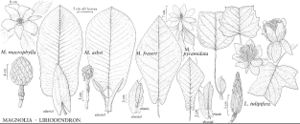Difference between revisions of "Magnolia fraseri"
Fl. Carol., 159. 1788.
FNA>Volume Importer |
FNA>Volume Importer |
||
| Line 17: | Line 17: | ||
|basionyms= | |basionyms= | ||
|synonyms={{Treatment/ID/Synonym | |synonyms={{Treatment/ID/Synonym | ||
| − | |name= | + | |name=Magnolia auricularis |
|authority=Salisbury | |authority=Salisbury | ||
| − | }}{{Treatment/ID/Synonym | + | }} {{Treatment/ID/Synonym |
| − | |name= | + | |name=Magnolia auriculata |
|authority=W.Bartram | |authority=W.Bartram | ||
}} | }} | ||
| Line 37: | Line 37: | ||
|elevation=300-1520m | |elevation=300-1520m | ||
|distribution=Ga.;Ky.;N.C.;S.C.;Tenn.;Va.;W.Va. | |distribution=Ga.;Ky.;N.C.;S.C.;Tenn.;Va.;W.Va. | ||
| − | |discussion=<p>Magnolia fraseri, a tree of the Appalachian mountains and upper piedmont, and its close congener M. pyramidata, of the lower piedmont and coastal plain, are sometimes confused taxonomically, but they differ in a series of good characters. Some investigators have treated them as geographic varieties or subspecies of M. fraseri. Magnolia fraseri differs from M. pyramidata in being a much larger tree with wide-speading branches, different leaf shape, larger flowers, more numerous stamens, and larger follicetums. In their present geographic distribution, these taxa are allopatric. In some localities M. fraseri may be abundant, as in the area near Sugar Grove, Smythe County, Virginia, where hundreds of specimens occur. It is a desirable flowering tree, occasionally cultivated.</p><!-- | + | |discussion=<p><i>Magnolia fraseri</i>, a tree of the Appalachian mountains and upper piedmont, and its close congener <i>M. pyramidata</i>, of the lower piedmont and coastal plain, are sometimes confused taxonomically, but they differ in a series of good characters. Some investigators have treated them as geographic varieties or subspecies of <i>M. fraseri</i>. <i>Magnolia fraseri</i> differs from <i>M. pyramidata</i> in being a much larger tree with wide-speading branches, different leaf shape, larger flowers, more numerous stamens, and larger follicetums. In their present geographic distribution, these taxa are allopatric. In some localities <i>M. fraseri</i> may be abundant, as in the area near Sugar Grove, Smythe County, Virginia, where hundreds of specimens occur. It is a desirable flowering tree, occasionally cultivated.</p><!-- |
| − | --><p>The largest known tree of Magnolia fraseri, 32.6m in height with a trunk diameter of 94 cm, is recorded from Great Smoky Mountains National Park, Tennessee (American Forestry Association 1994).</p> | + | --><p>The largest known tree of <i>Magnolia fraseri</i>, 32.6m in height with a trunk diameter of 94 cm, is recorded from Great Smoky Mountains National Park, Tennessee (American Forestry Association 1994).</p> |
|tables= | |tables= | ||
|references= | |references= | ||
| Line 51: | Line 51: | ||
|rank=species | |rank=species | ||
|parent rank=genus | |parent rank=genus | ||
| − | |synonyms= | + | |synonyms=Magnolia auricularis;Magnolia auriculata |
|basionyms= | |basionyms= | ||
|family=Magnoliaceae | |family=Magnoliaceae | ||
| Line 62: | Line 62: | ||
|publication year=1788 | |publication year=1788 | ||
|special status=Endemic;Selected by author to be illustrated | |special status=Endemic;Selected by author to be illustrated | ||
| − | |source xml=https://jpend@bitbucket.org/aafc-mbb/fna-data-curation.git/src/ | + | |source xml=https://jpend@bitbucket.org/aafc-mbb/fna-data-curation.git/src/8f726806613d60c220dc4493de13607dd3150896/coarse_grained_fna_xml/V3/V3_334.xml |
|genus=Magnolia | |genus=Magnolia | ||
|species=Magnolia fraseri | |species=Magnolia fraseri | ||
Revision as of 17:16, 18 September 2019
Trees, deciduous, single-trunked, to 25(-32.6) m. Bark gray to brownish, smooth. Pith homogeneous. Twigs and foliar buds glabrous. Leaves crowded in terminal whorl-like clusters; stipules (5.4-)7.6-9.5(-10) × 2-6 cm, abaxially glandular. Leaf blade rhombic-obovate to obovate-spatulate or oblanceolate, broadest near middle, gradually tapering to base, 20-30(-60) × 8-16(-27) cm, base deeply cordate or auriculate to somewhat truncate, apex obtuse to acute or somewhat acuminate; surfaces abaxially strongly glaucous, glabrous, adaxially deep green, glabrous. Flowers fragrant, 16-22 cm across; spathaceous bracts 2, abaxially glandular; tepals creamy white, the outermost greenish; stamens 100-200, 8-14 mm; filaments white; pistils 50-90. Follicetums ellipsoid, 5.5-10 × 2.5-5 cm, glabrous; follicles recurved, long-beaked, glabrous. Seeds lenticular, 7-10 mm, aril red. 2n=38.
Phenology: Flowering spring.
Habitat: Rich woods and coves
Elevation: 300-1520m
Distribution

Ga., Ky., N.C., S.C., Tenn., Va., W.Va.
Discussion
Magnolia fraseri, a tree of the Appalachian mountains and upper piedmont, and its close congener M. pyramidata, of the lower piedmont and coastal plain, are sometimes confused taxonomically, but they differ in a series of good characters. Some investigators have treated them as geographic varieties or subspecies of M. fraseri. Magnolia fraseri differs from M. pyramidata in being a much larger tree with wide-speading branches, different leaf shape, larger flowers, more numerous stamens, and larger follicetums. In their present geographic distribution, these taxa are allopatric. In some localities M. fraseri may be abundant, as in the area near Sugar Grove, Smythe County, Virginia, where hundreds of specimens occur. It is a desirable flowering tree, occasionally cultivated.
The largest known tree of Magnolia fraseri, 32.6m in height with a trunk diameter of 94 cm, is recorded from Great Smoky Mountains National Park, Tennessee (American Forestry Association 1994).
Selected References
None.
